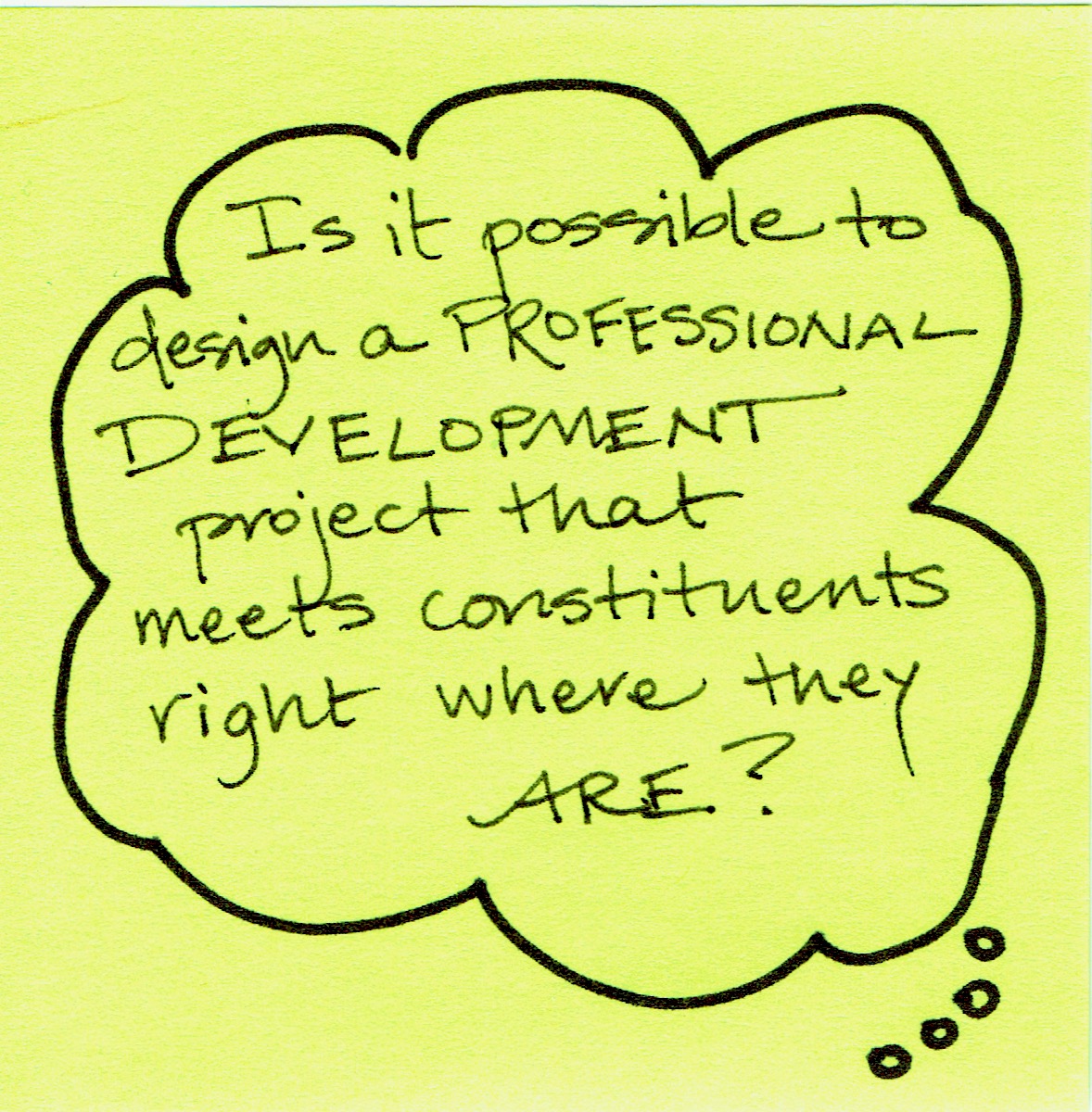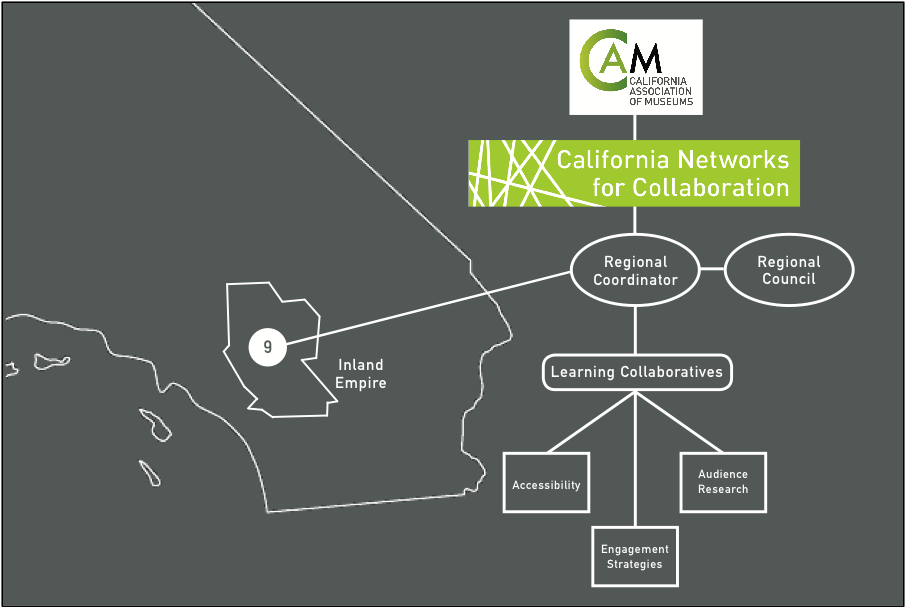by Ivy Young, Project Director, California Networks for Collaboration, California Association of Museums
In recent years, the California Association of Museums (CAM) and 13 other partner organizations joined together to oversee a collective vision for leveraging shared networks and providing professional development opportunities for museum workers throughout rural, suburban, and urban regions across California. This initiative is entitled the California Networks for Collaboration (CNfC), and it has recently concluded the second of four distinct phases in which the CNfC delivered a unique professional development program.

Museum associations, like the organizations they serve, face significant shifts in responding to 21st century learning models that emphasize new skills and practices that are learner-centered, self-directed, and multi-directional. Mindful of these shifts and sensitive to the need for more localized opportunities, CAM recognized an opportunity to reinvent programmatic delivery methods that rely less on traditional, didactic models. So, through a multi-stepped planning process to envision and guide the future of the association, CAM’s leadership developed a strategic plan in which a key strategy was to develop regional and collaborative learning networks across the state – what became the CNfC project.
I served as the Project Director for CNfC Phase 2, and I’d like to share a bit about the model we piloted for professional development with the hope that this may inspire those of you who serve other regional or state associations (as staff, board members, active constituents, or advisors).
In our quest to offer accessible professional development in regions throughout the state, CAM and the CNfC Steering Committee (comprised of representatives from all 13 partner organizations) designed a dispersed model for cultivating professional learning communities. First, we partitioned the state into 12 regions roughly defined by patterns of geographic similarities and population densities:

Then we conducted a search for Regional Coordinators to serve as learning facilitators in each region. On the ground, Regional Coordinators worked to activate already existing networks amongst museum professionals, promote the offering and galvanize participant interest, and to lead the regional learning communities.

To help the Regional Coordinators in this formidable undertaking, each assembled their own team of up to six local project advisors. These Regional Councils assisted in local network activation and in supporting the learning communities as they took shape and progressed.
To emphasize the collaborative nature of the participant experience, we named the CNfC learning communities “Learning Collaboratives”. We offered three different Learning Collaboratives, each focused on a separate, though interrelated, topic of study: Accessibility, Audience Research, and Engagement Strategies. All topics were offered in each of the 12 regions, so up to three different Learning Collaboratives ran simultaneously in each region.
The close-up example presented in the image below reveals CNfC stakeholders on the ground in each region:
- 1 Regional Coordinator (the local CNfC facilitator)
- 3-6 Regional Council members (local project advisors)
- 3 Learning Collaborative groups (each studying a different topic)

Zooming back out to a view of the whole state, you may see that many individuals were involved throughout various roles in supporting the CNfC Learning Collaborative groups:
- CNfC Steering Committee (representing CAM and 13 project partners)
- A Project Director
- 9 Content Advisors (who designed the three Learning Collaborative studies)
- 12 Regional Coordinators (1 per region)
- 12 Regional Councils (consisting of 3-6 members per region)
- 36+/- Learning Collaborative groups (with 1-3 different study groups per region, each ranging from 4-16 participants)

Should another association set out to build on this model for delivering professional learning opportunities across a dispersed geographical area, I recommend that you:
Anticipate Differences Across Rural and Urban Geographies
The needs of small, rural institutions are different than those of urban or even suburban institutions. While this may seem obvious to a certain extent, these differences influenced the very basis for all project communications. Intentionally design for regional adaptation and execution, but be explicit about the elements that may and may not be adapted to ensure project continuity.
Celebrate Your Staff
All regionally based staff serves as the face of your project. For deeper impact and stronger traction, appoint facilitators who reside in the region they represent and who are already well-established professionals there. Prior to expanding outwardly to participants, invest in staff training to forge and co-create a strong, shared community within the project.
Communicate Proactively and Repetitively
I cannot emphasize enough the importance of communicating repetitively to dispatch critical information across such large or intricate networks via every possible communication channel. When you think you’ve done this enough, communicate your message in a new and different way.
Strike a Balance Between Complexity and Adaptability
In directing the project, I embraced and modeled flexibility and transparency, and sought to promote inclusion and buy-in amongst staff and participants. While good, at times, I recognize that I also made processes more complicated than necessary. In any collaborative effort, striking such balance and adapting to unforeseen needs will always prove challenging – may you meet this balance with awareness and care.
As those involved in the California Networks for Collaboration can attest, there were many layers of collaboration taking place across this professional development initiative!

This project was made possible in part by the Institute of Museum and Library Services, grant number MG-10-14-0010-14, and with the generous support of all CNfC partner organizations.
-
- To learn more about the Learning Collaborative experience and design, please read the partner WestMuse blog post coming soon.
- The CNfC website provides a project overview and links to other resources, including participant takeaways.
- The CNfC Phase 2 Final Report details more findings from the Learning Collaborative pilot.
- To learn more about the Learning Collaborative experience and design, please read the partner WestMuse blog post coming soon.








Add new comment